

UNO and Friends is a multiplayer card game published by Gameloft on the Google Play Store and Apple App Store. With over ten million downloads and a rating of 4/5 aggregated from over 860,000 reviews, it’s clear that UNO and Friends has a large player base that continues to enjoy the game. However, is the game worthy of its audience and rave reviews? In this review, I touch on the positive and negative aspects of UNO and Friends while offering Tips Tricks and Cheats to make your play experience as enjoyable as possible.
UNO and Friends is a mobile adaptation of the classic card game UNO. While for the most part the rules remain the same, the adaptation to mobile phones offered Gameloft a lot of opportunities to add more features that take an old, albeit beloved, game and add some extra content and twists to keep the game appealing to current audiences.
Before exploring the large amount of content Gameloft offers in UNO and Friends, it’s helpful to have a quick refresher on the rules of classic UNO.
UNO, an American card game originally released in 1971, has seen multiple iterations since its creation that add little quirks to the game. However, the original format is still the most widely recognized.
The UNO deck consists of 108 cards. These cards are divided into four colors (Green, Red, Blue, Yellow) with two of each number from 1-9 in every color. The deck also consists of one 0 card in each suit as well as 1-2 of each action card, the significance of which is discussed below.
Seven cards are dealt to everyone playing, a card is turned face up, and gameplay moves clockwise starting with the player to the dealer’s left. The objective of the game is to be the first one to be left with an empty hand.
Players take turns playing cards, though they can’t simply play whatever card they want. Each card played must match either the color or number of the card currently on top of the stack, with a few notable exceptions. If players don’t have a card they can play, they draw from the deck and can play it immediately if the drawn card matches the top of the stack. If the drawn card doesn’t match or the player doesn’t want to play it immediately, play continues as normal.
Directly before playing their second to last card, players must say UNO. If that player neglects to say UNO and second player catches the mistake before play continues, the first player has to draw two cards.
Officially, when a player “goes out”- that is, plays their last card – they receive points totaling the face value of all the cards held by each other player, with each action card counting for twenty points. Multiple rounds are played with the first player to reach 500 points declared the winner.
In practice, most players of UNO consider the winner of the round to be the winner of the game and just continue to play rounds (perhaps keeping a tally of how many wins each player has) until they’d like to stop playing. UNO and Friends also doesn’t operate using the 500 goal, with winners being declared after each round.
Action cards are cards that change gameplay beyond simply playing cards in a circle. There are five action cards: Skip, Draw Two, Reverse, Wild, and Wild Draw Four.
Skip is self-explanatory, and when played, skips the turn of the next player.
Draw Two makes the next player draw two cards.
Reverse reverses the current order of turns. When played, the player who played before you plays the next turn rather than the player who normally would come next. This reversed order continues indefinitely until another reverse card is played.
Wild and Wild Draw Four are relatively similar, though there are special rules governing when Wild Draw Four can legally be played. Wild cards can be played at any time on any color, and allow the player to declare a new color that replaces the current one and must be played starting with the next player. Wild Draw Four, in the same vein, allows players to change the current color as well as forcing the next player to draw four cards.
However, players can’t play Wild Draw Four if they have another card that is playable on the current stack. If a wild draw four is played and the next player suggests that the current player has another viable card, he can challenge said player. If the player actually doesn’t have any other cards that can be played, the challenging player suffers a penalty and must draw six cards rather than the original four. If the current player is found to be cheating, they must draw four cards in place of the challenging player.
UNO and Friends, while generally following the basic UNO Format at its core, makes some interesting additions that offer a lot of variation to the pretty simple basic card game.
In addition to a matchmaking system that allows you to find other players at will no matter what time of day or location you’re playing from, Gameloft added several systems that encourage interaction, cooperation, and competition with your fellow players.
UNO and Friends contains different “Houses” that players are assigned to as they continue to play the game. Each house is named for one of the colors present in the game – green, red, yellow, and blue. Players work together with their house to score more points than their competitors. Each competition period eventually declares a winner, and the winning house gets access to an exclusive champion tournament during their reign that offers greater rewards than the normal competition, or even completely different items in some cases.
To help out their house, players complete and climb in their league and/or complete daily missions.
A league is a collection of players sorted based on skill level. By playing regular games, players climb (or fall) on a ranking board based on their position in games. Earning points moves players into higher divisions and, after advancing through four divisions, a new league.
Daily missions are basic achievements like those found in other games that reward you with points for completing in-game tasks such as “call UNO 4 times” or similar objectives.
Outside of helping your house, you can take part in one of many tournaments. Though tournaments vary in many ways, the basic format is the same. Each tournament starts with sixteen players. These players are split into four games. The winners of each game play a game and the winner of that second game is declared the winner.
There are two currencies in UNO and Friends: Tokens, and Coins. Tokens are used to enter games and tournaments and are purchased using real money or obtained several ways for free in-game. Check out the Tips, Tricks, and Cheats section for specifics on these methods. This currency is the most important as even the most basic game costs two tokens.
Coins are used for a lot of aesthetic purchases as well as buying boosts. These can be purchased with real money, but are relatively easy to collect just by playing games, with an amount awarded based on the points gained for doing well in games.
Boosts
Though not necessary at lower levels, having boosts available to use during play will give players an edge that can carry them into the more advanced leagues. Boosts consist of New Hand, 50% Bonus, Dampener, Mirror, Spy, and Overdraw.
New Hand allows you to swap your hand once per game.
50% point bonus allows you to get 50% more points from games for a short period of time.
Dampener is a defensive boost that cuts the amount of cards you have to draw from action cards – known as special cards in the mobile game – in half.
Mirror makes opponents who force you to draw also draw the same amount of cards themselves.
Spy allows you to look at an opponent’s hand.
Overdraw makes opponents draw two cards instead of one.
Players who make use of boosts can often turn a bad game in their favor, as a lot of these boosts offer some strategy to the game and, in all cases, give you a leg up on non-boosted players.
Coins, gems and tokens are really vital for Uno & Friends, because you need these items in order to progress through the game and get all the items you need. Gems, tokens, and coins are available in the app store, but it costs real money to purchase, and this gets expensive quickly.
Look at the image below to see just how easy the Uno & Friends hack tool is to use. All you do is enter the amounts of coins, gems, and tokens that you want in the options menu.
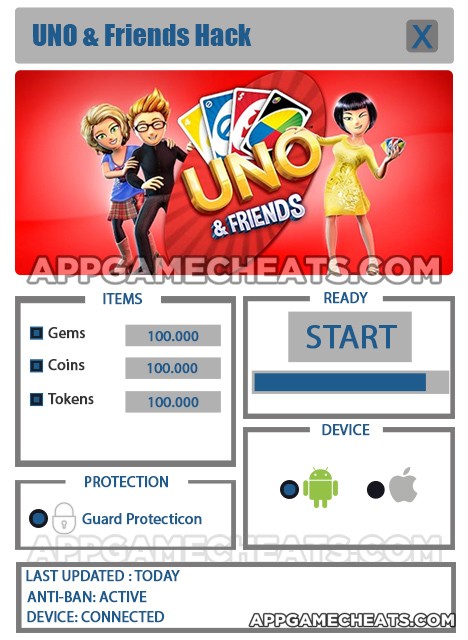
If you would like to get the coins, gems, and tokens for free, download our Uno & Friends hack tool, which takes around 20 seconds. The hack tool automatically installs too, which takes around 30 seconds. You can then choose Android or iOS depending on the type of device you are using. After that, you just enter the tokens, coins, and gems you would like to add to your account.
Lastly, when you are ready, tap on “Start” to begin the Uno & Friends hack tool, and the process takes less than 30 seconds to complete. You can then open up the app on your device to find the items sitting in your account ready to use.
Tokens are the most valuable currency in the game, and while players are granted an initial amount upon first downloading the app, they will quickly burn through them. Though the easiest way to obtain these is with a cash shop purchase, there are several free ways to earn them.
The first is by getting a win streak. Though not reliable, this will happen from time to time and give players a little chunk of tokens.
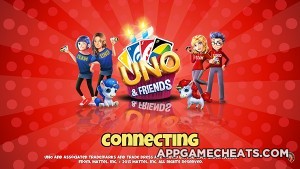
Players receive tokens from watching paid advertisements, but this method is limited to a gain of four tokens a day.
Scratchers are like lottery tickets and can actually serve as a cost-effective way to get tokens should you decide to make a purchase. Even without spending real money, players are given 3 free scratchers a day up to a certain threshold, at which they will completely stop getting them for free.
Upon leveling up you receive one free token.
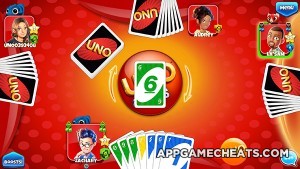
Finally, tokens are often also given as a reward for ranking on leaderboards.
I really like the idea of UNO and Friends, but I’m really bothered by the way they handled Tokens. Tokens are required to play games and enter tournaments. Basic games only cost two tokens but the tournaments – which offer the bulk of the game’s rewards – can get prohibitively expensive very quickly. While there are a few ways to earn free tokens, they’re either a one-time bonus, unreliable, or just not plain efficient enough to warrant wasting my time on. Ultimately, if I wanted to play this long term and be competitive about it, I would basically have to fork over cash at some point unless I wanted my climb to come to a screeching halt.
It’s normal for a studio to try to make a lot from their games, but there are dozens of other games that are extremely profitable while at the same time allowing players a viable option to continue playing for free. Players can provide profit even without any purchases by providing advertisement views and referring their friends. Though technically a “free” game, this game definitely requires monetary investment beyond the most casual players.
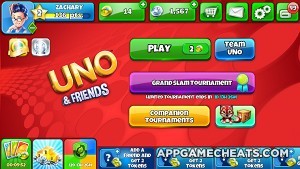
Add to this the big advantage having a lot of boosts stacked up can give you over non-boosted players, and it quickly begins to seem like the game is pay-to-win. While I wouldn’t go as far as to call it pay-to-win, it definitely shares some of those aspects. Some of the skill of the game is lost when you can just toss boosts around left and right, and though some may argue (I even mentioned this a bit above) that strategy and complexity can be added to the game by learning when the ideal situation is to play a boost, it still seems possible to obtain an unfair advantage by throwing money at the game.
Other than these mechanics and the rare annoying popup ad, I’d say the game is pretty good. There’s a lot of options for competitive players to continue to challenge themselves while at the same time offering a basic game for a pretty low token amount for people who just want to be matched with other players for a low stress game of UNO (at least until they run out of tokens.)
The good of this game was kind of spoiled by prohibitive paywall I see looming in the distance. It seems like a poor place to spend my time if my progress is eventually going to be reliant on cash purchases.
For people who don’t mind sinking money into a game, I can highly recommend UNO and Friends. For others that want their free games to be truly free, I would label this one as a pass.
Artwork: The artwork is generic and cartoony, though the bright colors are nice. I really wouldn’t say UNO and Friends excelled with its artwork, but it didn’t fall short either. Completely middle of the road. Rating: 5/10
Music / Sound Effects: The music and sound effects are nothing to write home about. They serve their purpose but I wasn’t very impressed. Rating: 3/10
Story / Originality: There is no story to the game but I can’t fault the developers for that as it’s a mobile card game. There was definitely some originality in some of the features added, such as the special boosts that make the card game a little different from the basic UNO style as well as the multitude of options available for multiplayer play. Rating: 7/10
General Gameplay: Gameplay is pretty fun and will appeal to fans of card games. However, the fact that the game at some point will become next to impossible to continue playing without micro-transactions is unforgivable for me. Rating: 3/10
Addictiveness: The game definitely has an addictiveness factor for any gamer that enjoys a good competition. There are multiple ways to test yourself against opponents and players are generally matched with players of comparable skill level ensuring that there will always be a challenge no matter how much of an UNO master players are. Rating: 9/10
Overall Rating: Simply said, UNO and Friends had a good concept and ruined it with poor monetization. Though this game may be worth downloading just to give it a try, I can’t in good conscience recommend it. Rating: 4/10




 The List App guide: How to get started with addictive list making
The List App guide: How to get started with addictive list making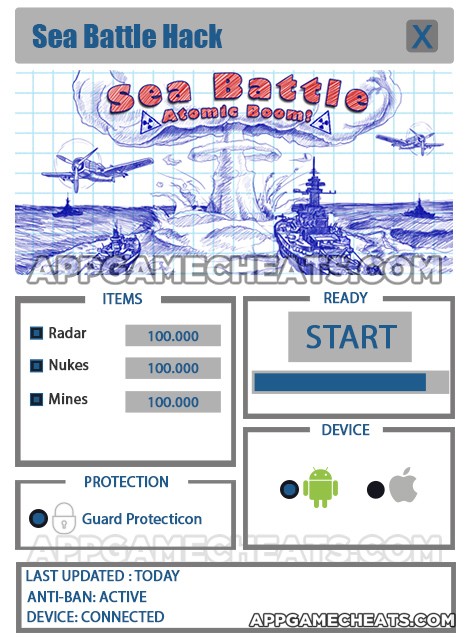 Sea Battle Cheats & Hack for Radar, Nukes & Mines - AppGameCheats.com
Sea Battle Cheats & Hack for Radar, Nukes & Mines - AppGameCheats.com Guess The 90s Level 52 Answers
Guess The 90s Level 52 Answers Big TV Quiz Level 1 Answers and Solutions
Big TV Quiz Level 1 Answers and Solutions How to walk the walk in Nimble Quest - hints, tips, and tricks
How to walk the walk in Nimble Quest - hints, tips, and tricks